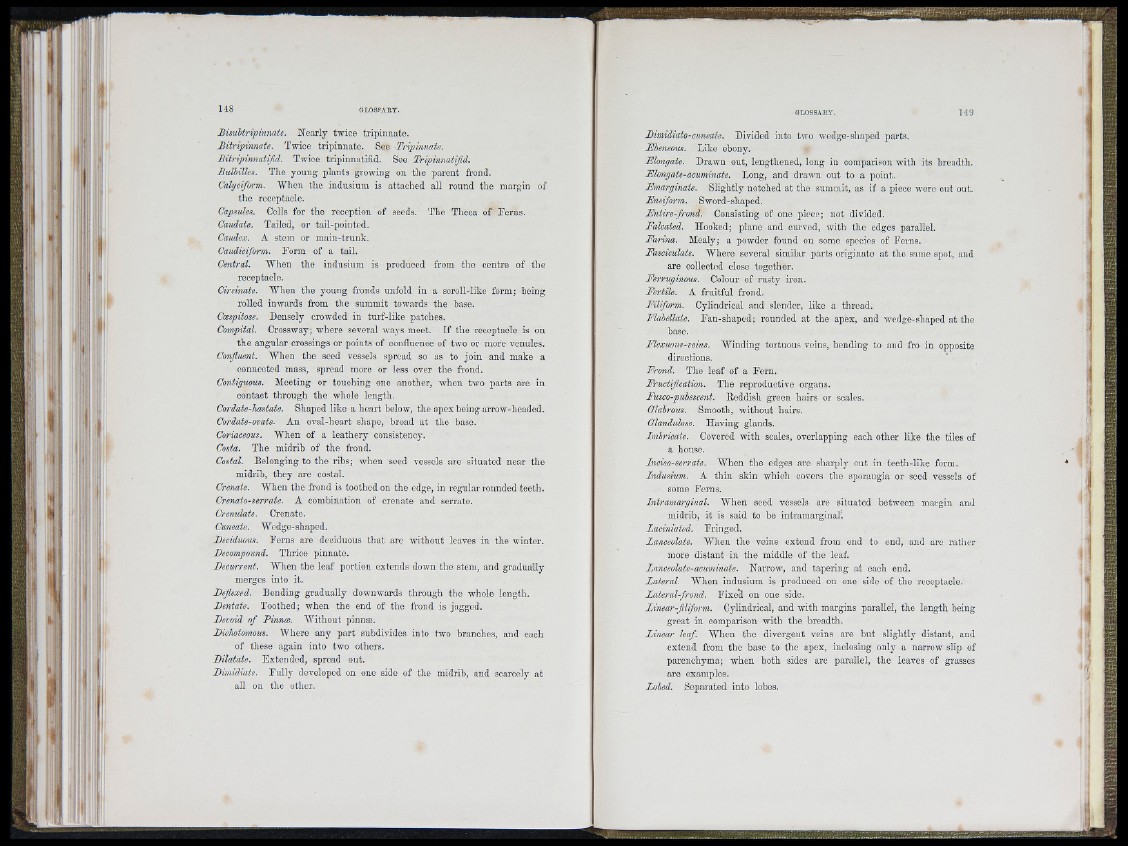
II
'*i:
I
i. 1
BisuUripinnate. Nearly twice tripinnate.
Bitripinnate. Twice tripinnate. See Tripinnate.
Bitripinnatifiâ. Twice tripinnatifid. See Tripinnaüfid.
Bulhüles. The young plants growing on tlie parent frond.
Calyciform. AVhen the indusium is attached all round the margin of
the receptacle.
Capsules. Colls for the reception of seeds. The Theca of Ferns.
Caudate. Tailed, or tail-pointed.
Caude.v. A stem or main-trunk.
Caudiciform. Form of a tail.
Central. AVhen the indusium is produced from the centre of the
receptacle.
AVhen the young fronds unfold in a scroll-like form; being
rolled inwards from the summit towards the base.
Densely crowded in turf-like patches,
Compital. Crossway; w'here several ways meet. If the receptacle is on
the angular crossings or points of confluence of two or more venules.
Confluent. AVhen the seed vessels spread so as to join and make a
connected mass, spread more or less over the frond.
Contiguous. Meeting or touching one another, when two parts are in
contact through the whole length.
Cordate-hastate. Shaped like a heart below, the apex being arrow-headed.
Cordate-ovate. An oval-heart shape, broad at the base.
Coriaceous. AVhen of a leathery consistency.
Costa. The midrib of the frond.
Costal. Belonging to the ribs; when seed vessels are situated near the
midrib, they are costal.
Crenate. AVhen the frond is toothed on the edge, in regular rounded teeth.
Crenaio-serrate. A combination of crenate and serrate.
Crenulate. Crenate.
Cuneate. AVedge-shaped.
Deciduous. Ferns are deciduous that are without leaves in the winter.
Decompound. Thrice pinnate.
Decurrent. AVhen the leaf portion extends down the stem, and gradually
merges into it.
Deflexed. Bending gradually downw-ards through the whole length.
Dentate. Toothed; when the end of the frond is jagged.
Devoid of Pinnæ. AA’ithout pinnæ.
Dicliotomotis. AVhere any part subdivides into two branches, and each
of these again into two others.
Dilatate. Extended, spread out.
Dimidiate. Fully developed on one side of the midrib, aud scarcely at
all on the other.
Dimidiato-cuneate. Divided into two wedge-shaped parts.
Eleneous. Like ebony.
Elongate. Drawn out, lengthened, long in comparison with its breadth.
e-acuminate. Long, and drawn out to a point.
Slightly notched at the summit, as if a piece were cut out.
Ensiform. Sword-shaped.
Ettire-frond. Consisting of one piece; not divided.
Falcated. Hooked; plane and curved, with the edges parallel.
Farina. Mealy; a powder found ou some species of Ferns.
Fasciculate. AVhere several similar parts originate at the same spot, and
are collected close together.
Ferruginous. Colour of rusty iron.
Fertile. A fruitful frond.
Filiform. Cylindrical and slender, like a thread.
Flahellate. Fan-shaped; rounded at the apex, and wedge-shaped at the
base,
Flexiam-veins. AVinding tortuous veins, bending to and fro in opposite
directions.
Frond. The leaf of a Fern.
Fructification. The reproductive organs.
Fusco-puleseent. Eeddish green hairs or scales.
Glabrous. Smooth, without hairs.
Glandulose. Having glands.
Imbricate. Covered with scales, overlapping each other like the tiles of
a house.
Inciso-serrate. AVhen the edges ai-e sharply cut in teeth-like form.
Indusium. A thin skin which covers the sporangia or seed vessels of
some Ferns.
Intramarginal. AVhen seed vessels are situated between margin and
midrib, it is said to be intramarginal'.
Laoiniated. Fringed.
lanceolate. M‘hen the veins extend from end to end, and are rather
more distant in the middle of the leaf.
Lanceolate-acuminate. Narrow, and tapering at each end.
Lateral. AVhen indusium is produced on one side of the receptacle.
Lateral-frond. Fixe'd on one side.
Linear-filiform. Cylindrical, and with margins parallel, the length being
great in comparison with the breadth.
Linear leaf. AVhen the divergent veins are but slightly distant, and
extend from the base to the apex, inclosing only a narrow slip of
parenchyma; when both sides are parallel, the leaves of grasses
are examples.
Lobed. Separated into lobes.
m